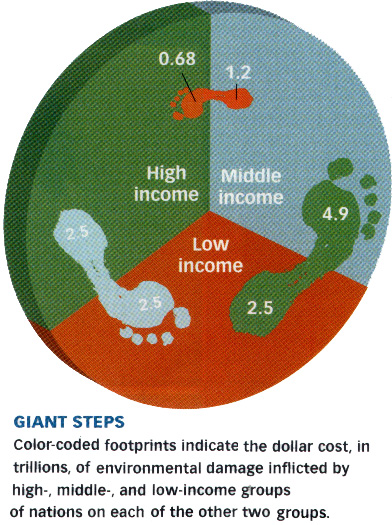Personalizing our
footprint on the earth: with mastery or dominion comes duty.
If the last supper were held today,
900 calories eaten would need 9000 calories of oil to produce!
Human impact is a vague, abstract and controversial concept. But imagine daily what you do and how you do it.
Consider the sum total or aggregate affect of all you do in comparison to a footprint you leave in the sand. By analogy, the sand is the functionally necessary life sustaining qualities of the earth. Your footprint together with 7 billion others is a metaphor for how we impact the planet. As we master the earthÕs many products we leave our prints on everything we use.
A footprint is
a reminder of how lasting, deep, broad and intense our presence was.
Consumption | Energy | Water | Land | Food
![]()
To
be explicit: Americans consume over 500 liters of water and 30 kWh per person
per day.
10 calories of energy
are required in the US to put 1 calorie of food on our tables.
Each American requires
10 acres (ghost acres) of land to sustain current living standards.
US weekly average meat
consumption is equal to a person from IndiaÕs annual average;
2,740 calories of food
per capita per day is an average amount of necessary food energy.
20 tons of carbon
dioxide / person, annually in US: 1
ton / capita annually global average.
Energy (the land to fuel connection and water to electricity partnership)
Energy
means the ability to do work by means of animal or human labor, combustion,
electricity {wind, geothermal, solar, fossil fuels}, or thermonuclear
reactions.
24% (<1/4) of the worldÕs commercial
energy is used in the US. (<3% in India)
93% of all commercial energy in the USA comes from non - renewable sources
(85% fossil & 8%
nuclear fuels).
83% of all commercial energy in the world comes from non - renewable sources
(78% fossil & 5%
nuclear fuels).
Fossil fuels (the fuel to food connection)
Coal
Coal
provides 76% of ChinaÕs energy needs and 22% of US energy needs.
Coal
produces 64% of the global electricity and 57% of the US electricity.
65,000
-200,000 people in USA die annually from coal burning.
42%
of global greenhouse gas -- GHG-- emissions are from coal.
The
US has 2/3 of all coal reserves on earth and there are 300 years of coal
reserves remaining, globally, at
current consumption rates.
Oil
42%
of the commercial energy use in the world came from oil (1992)
39%
of all known oil on earth is consumed by the US.
Current
oil use in US means known reserves (2.3% of the global total) will last through
2020, & world to 2050.
1998 66%
of all oil was used for transportation, up from 53% in 1973.
1997 55%
of US oil was imported, up from 36% in 1973.
Agriculture (the land to food connection)
17% of all commercial energy used in the USA is for agriculture & accounts for 25% of the food and fiber produced worldwide, feeding 105 Americans stateside and 35 residents overseas.
1.8% or
650,000 Americans are full time farmers!
41% of the water
pumped in the US is for irrigation of crops (70-80% evaporates)
26 billion tons of
topsoil erodes annually (over four tons/ capita annually).
1/3 of all cropland globally is becoming too eroded and 1/10 is waterlogged from irrigation,
1/4 is
highly saline from irrigation. [.33 + .25 + .1 = .59 or 59% of cropland is
damaged!]
14% of US topsoil loss
is from overgrazing of livestock. 1/2 our water goes to livestock.
17% of the planetÕs
arable (crop) land is irrigated and producing 40% of the worldÕs food.
70% of US grain is fed
to livestock; compared to 37% worldwide.
19% of US cropland is
devoted to livestock while 50% is globally.
11% of the planetÕs
surface is now used and able to grow crops (arable). (24% could be used,
allegedly)
Food:
1/4
of all food in the US is wasted.
10-18 million people
die annually from hunger related causes (children and elderly).
840 million people on
Earth were malnourished (< 940 million in 1970) in 1995.
11% of the earth is
arable land, or suitable for crops (livestock).
Of the 30,000 edible
plants most people eat 15 kinds: mostly rice, corn, wheat & potatoes!
Consumption | Energy | Water | Land | Food
![]()
Film as a medium | Film Art | Open Space of Democracy |Ecological literacy | economy
Last Updated on 10/31/2011 .
schedule | Research home | Atlas | site-map | Ecology | laws | reliable web sites | quick look
Science Index | Site Analysis | Population Index | Global Warming Index | Nature Index | Research sites | Genes
Terms | Glossary | Word webs | Basic words | Advanced Vocabulary | Antonyms | Synonyms | Etymology | Concepts

